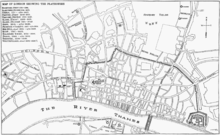Cockpit Theatre

The Cockpit was a theatre in London, operating from 1616 to around 1665. It was the first theatre to be located near Drury Lane. After damage in 1617, it was named The Phoenix.
History

The original building was an actual cockpit; that is, a staging area for
In August 1616, Christopher Beeston acquired the lease to the building and converted it to an indoor playhouse.[4] In March 1617, rioting apprentices attempted to destroy the playhouse, probably out of anger that their favorite plays had been removed from the Red Bull outdoor amphitheater, which charged only one penny for admission, to this more expensive (six-penny) venue. The actors shot at the rioters, killing three. The apprentices entered the building and cut up the costumes.[5]
Beeston's rapid restoration of the playhouse after the riot may explain why it was sometimes called the Phoenix.[6] Like earlier theatres, such as The Theatre in Shoreditch and The Globe in Southwark, the location was just outside the jurisdiction of the City of London. Beeston expanded the original small building; the construction work prompted complaints by neighbors, which left traces in the legal records of the time.[7] The resulting theatre was, by one estimate, 52 feet (16 m) by 37 feet (11 m), "noticeably smaller than the Blackfriars."[6]
The architect commissioned for the renovation is not known for a certainty, but circumstantial evidence points to Inigo Jones. Two sheets drawn by Jones and showing the interior and exterior design of some theatre have survived; John Orrell makes the case that the theatre is the Cockpit, while allowing that he cannot produce conclusive evidence to that end.[8] (In 1629, Inigo Jones would design another "Cockpit" theatre, a private one within Whitehall called the Cockpit-in-Court or Royal Cockpit.)
Beeston intended the Cockpit to serve as an indoor complement to the Red Bull, the outdoor theatre then home to his acting troupe, Queen Anne's Men. A winter venue was needed to compete with the Blackfriars Theatre in the possession of their rival troupe, the King's Men. After a rocky start, the company proved successful in their new locale. Wickham attributes the success more to the theatre's location and comfort and to the flair of its manager, Beeston, than to the quality of its performers.[9]
Beeston would oversee several different troupes in the Cockpit before his death in 1639.
William Beeston was forced out of the theatre when his choice of plays met with the disapproval of the Court. He was replaced by
The theatres were permitted to reopen after the
In 1663, Killigrew's King's Company opened the Theatre Royal, Drury Lane nearby. The Cockpit was unable to compete with this relatively grand new theatre and was further hamstrung since it was shut out of the monopoly on "legitimate drama" granted to the two patent companies. There is no record of any play being mounted at the Cockpit after 1665; the eventual fate of the structure is unknown.
The Phoenix was located in the middle of the area bounded today by Drury Lane, Great Queen Street, Great Wild Street, and Kemble Street. The entrance to the theatre was in Cockpit Alley, which ran from Drury Lane to Great Wild Street; the present-day Martlett Court is off Drury Lane roughly opposite where the entrance to Cockpit Alley was.[13]
Notes
- JSTOR 43447083.
- ISBN 9780521255462.
- ^ Gurr and Orrell, p. 142.
- ^ Wickham, p. 117.
- ^ Elizabeth McClure Thomson, The Chamberlain Letters (London, 1966), p. 140.
- ^ a b Gurr, Shakespearean Stage, pp. 24-25.
- ^ Gurr and Orrell, pp. 142-3.
- ^ Shakespeare Survey 30, p. 157.
- ^ Wickham, p. 118.
- ^ Thomson. p. 225; Harbage, p. 356.
- ^ Gurr and Orrell, p. 146.
- ^ Thomson, p. 225.
- ^ Berry, 623.
References
- Herbert Berry, "The Phoenix". In Glynne Wickham, Herbert Berry, and William Ingram, editors, English Professional Theatre, 1530–1660. Cambridge: Cambridge University Press, 2000. 623–637.
- Gurr, Andrew, with John Orrell(1989). Rebuilding Shakespeare's Globe. New York, Routledge.
- Gurr, Andrew (1992). The Shakespearean Stage. Third edition, Cambridge, Cambridge University Press.
- Harbage, Alfred, et al. (1989). The Annals of English Drama 975–1700. London: Routledge.
- Orrell, John (1977). "Inigo Jones at The Cockpit", Muir, Kenneth ed. Shakespeare Survey 30. Page references are to the 2002 paperback edition.
- Thomson, Peter (1995). "Cockpit Theatre", Banham, Martin The Cambridge Guide to Theatre. Cambridge University Press, p. 225.
- Wickham, Glynne (1972). Early English Stages 1300 to 1660: Volume Two 1576 to 1660, Part II. London: Routledge.
See also
External links
- 'Drury Lane Theatre', Old and New London: Volume 3 (1878), pp. 218–27.
- The Diary of Samuel Pepys
- Inigo Jones designs a stage
- Shakespearean Playhouses, by Joseph Quincy Adams Jr. from Project Gutenberg
